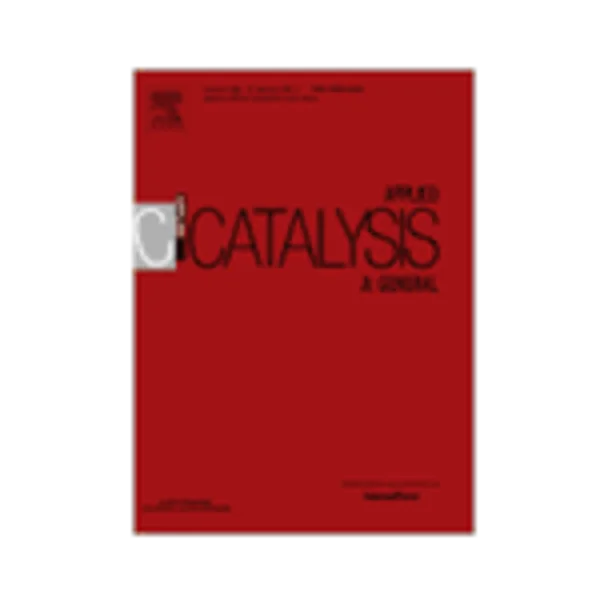-
effect of (zn(oh)2)3(znso4)(h2o)5 on the performance of ru–zn catalyst for benzene selective hydrogenation to cyclohexene
جزئیات بیشتر مقاله- تاریخ ارائه: 1392/07/24
- تاریخ انتشار در تی پی بین: 1392/07/24
- تعداد بازدید: 981
- تعداد پرسش و پاسخ ها: 0
- شماره تماس دبیرخانه رویداد: -
a series of ru–zn catalysts with different zn contents were prepared by co-precipitation. the catalysts were characterized by x-ray diffraction (xrd), x-ray photoelectron spectroscopy (xps), auger electron spectroscopy (aes) – ar+ sputter, transmission electron micrographs (tem)–energy dispersion scanning (eds) and temperature-programmed reduction (tpr). the performances of the catalysts for benzene selective hydrogenation to cyclohexene were investigated in the presence of 0.6 mol/l of znso4. the results showed that the ru and zn in ru–zn catalyst were in metallic ru and zno respectively and the zno was rich on the surface. the zno alone could not improve the selectivity to cyclohexene of ru–zn catalyst. however, the zno on the surface could react with znso4 to form a (zn(oh)2)3(znso4)(h2o)5 salt. the (zn(oh)2)3(znso4)(h2o)5 salt chemisorbed played a key role in improving the selectivity to cyclohexene of ru–zn catalysts. after ru–zn(8.6%) catalyst was pretreated 22 h in znso4 solution at 140 °c and 5 mpa h2, a cyclohexene selectivity of 81.4% at a benzene conversion of 54.0% was achieved at 10 min and a maximum cyclohexene yield of 58.9% was reached. moreover, the activity was stable above 50% and the cyclohexene selectivity and yield were steadily above 76% and 40% on this catalyst in the first six recycles, respectively.
مقالات جدیدترین رویدادها
-
استفاده از تحلیل اهمیت-عملکرد در ارائه الگوی مدیریت خلاقیت سازمانی و ارائه راهکار جهت بهبود
-
بررسی تاثیر ارزش وجوه نقد مازاد بر ساختار سرمایه شرکت های پذیرفته شده در بورس اوراق بهادار تهران
-
بررسی تأثیر سطح افشای ریسک بر قرارداد بدهی شرکت های پذیرفته شده در بورس اوراق بهادار تهران
-
بررسی تأثیر رتبه بندی اعتباری مبتنی بر مدل امتیاز بازار نوظهور بر نقد شوندگی سهام با تأکید بر خصوصی سازی شرکت ها
-
تأثیر آمیخته بازاریابی پوشاک ایرانی بر تصویر ذهنی مشتری پوشاک ایرانی (هاکوپیان)
-
مقایسه اثر فلوکونازول و گریزئوفولوین بر کچلی سر
-
بررسی آزمایشگاهی رشد حباب محلول غیر الکترولیت آب و اتانول در جوشش استخری روی استوانه استیل افقی
-
رتبه بندی واحدهای پالایشگاه گاز جهت بازیابی گرمایی به روش تحلیل سلسه مراتبی
-
بررسی نقش نیتریک اکساید در گشادی عروق کرونر حاصل از عصاره پاغازه (falcaria vulgaris) در قلب مجزای موش صحرایی
-
electrohydrodynamic dispersion of deformable aerosols in the presence of an electric field and chemical reaction using taylor dispersion model
مقالات جدیدترین ژورنال ها
-
مدیریت و بررسی افسردگی دانش آموزان دختر مقطع متوسطه دوم در دروان کرونا در شهرستان دزفول
-
مدیریت و بررسی خرد سیاسی در اندیشه ی فردوسی در ادب ایران
-
واکاوی و مدیریت توصیفی قلمدان(جاکلیدی)ضریح در موزه آستان قدس رضوی
-
بررسی تاثیر خلاقیت، دانش و انگیزه کارکنان بر پیشنهادات نوآورانه کارکنان ( مورد مطالعه: هتل های 3 و 4 ستاره استان کرمان)
-
بررسی تاثیر کیفیت سیستم های اطلاعاتی بر تصمیم گیری موفق در شرکتهای تولیدی استان اصفهان (مورد مطالعه: مدیران شرکتهای تولیدی استان اصفهان)
-
اثربخشی آموزش راهبردهای حافظه فعال بر انگیزش تحصیلی و اضطراب امتحان دانش آموزان
-
شناسایی و اولویت بندی انواع ریسک در پروژه های روستایی و پاسخ به آنها
-
بررسی علل تخریب محیط زیست در گذار به اقتصاد سبز
-
an investigation into risk factors for knee arthroplasty as a knee osteoarthritis (oa) treatment
-
flexural performance of composite ultra-high-performance concrete-encased steel hollow beams




سوال خود را در مورد این مقاله مطرح نمایید :